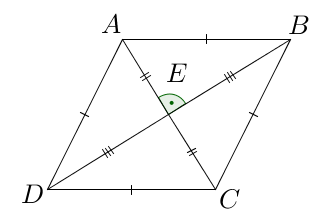Why the Area of a Rhombus is Half the Product of its Diagonals
A rhombus is a parallelogram with four congruent sides. Since it is a parallelogram, it has also all the properties of a parallelogram. One of these properties is that the diagonals bisect each other. That is, they divide each other into two equal parts.
Another property of a rhombus is that the diagonals are perpendicular. So, summarizing all the properties above, if we have rhombus , then,
.
and
.
From the figure below, it is clear that if we divide the parallelogram into two triangles, and
,
and
are their altitudes because they are perpendicular to
.

To find the area of parallelogram , first we find the area of triangle
, and then multiply it by 2. This is because triangle
is congruent to triangle
by SSS congruence (can you see why?).
Now, we know that the area of a triangle is 1/2 the product of the base and the height, so
area of triangle .
But we also know that is half of
, so
Area of .
Now, to get the area of ABCD, we multiply the area of ABC by 2. That is,
Area of parallelogram
This is what we want to prove: the area of parallelogram is half the product of diagonals
and
.